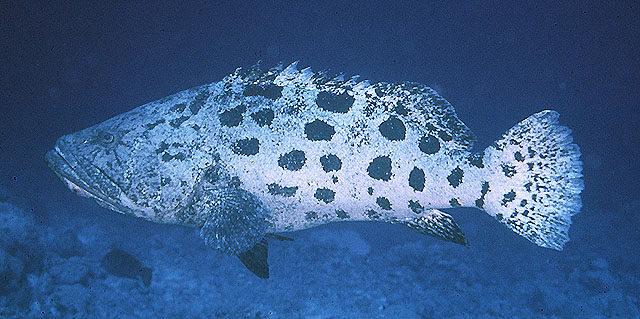| Epinephelidae (Groupers) |
| 200 cm TL (male/unsexed); max.weight: 110 kg |
|
reef-associated; marine; depth range 10 - 400 m |
| Indo-West Pacific: Red Sea and East Africa to southern Japan and Queensland, Australia. Also from the Paracel Islands in the South China Sea. There are no records from Madagascar, Mauritius, Maldives, Laccadives, and Sri Lanka, Indonesia, and the Philippines. |
|
Dorsal spines (total): 11-11; Dorsal soft rays (total): 14-15; Anal spines: 3-3; Anal soft rays: 8-8. Distinguished by the following characteristics: body depth contained 2.9-3.5 times in SL; head length 2.3-2.6 times in SL; slightly convex interorbital area; straight dorsal head profile; rounded or subangular preopercle, slightly enlarged serrae at angle; almost straight upper edge of operculum; posterior and anterior nostrils subequal in size; maxilla reaches to or beyond vertical at rear edge of eye; 2-6 rows of teeth on midlateral part of lower jaw (Ref. 89707). |
| Mainly found in deep reef channels and seamounts, in current prone areas (Ref. 48635). Juveniles may be found in tide pools (Ref. 5222). Feeds on reef fishes, skates, crabs, and spiny lobsters (Ref. 5222). Considered to be exceedingly territorial and very aggressive towards intruders. Vulnerable to spear fishers (Ref. 5222). Hand fed by divers in certain areas, but potentially dangerous to the inexperienced. In the Hong Kong live fish markets (Ref. 27253). Solitary (Ref 90102). |
|
Least Concern (LC); Date assessed: 22 November 2016 Ref. (130435)
|
| harmless |
Source and more info: www.fishbase.org. For personal, classroom, and other internal use only. Not for publication.

